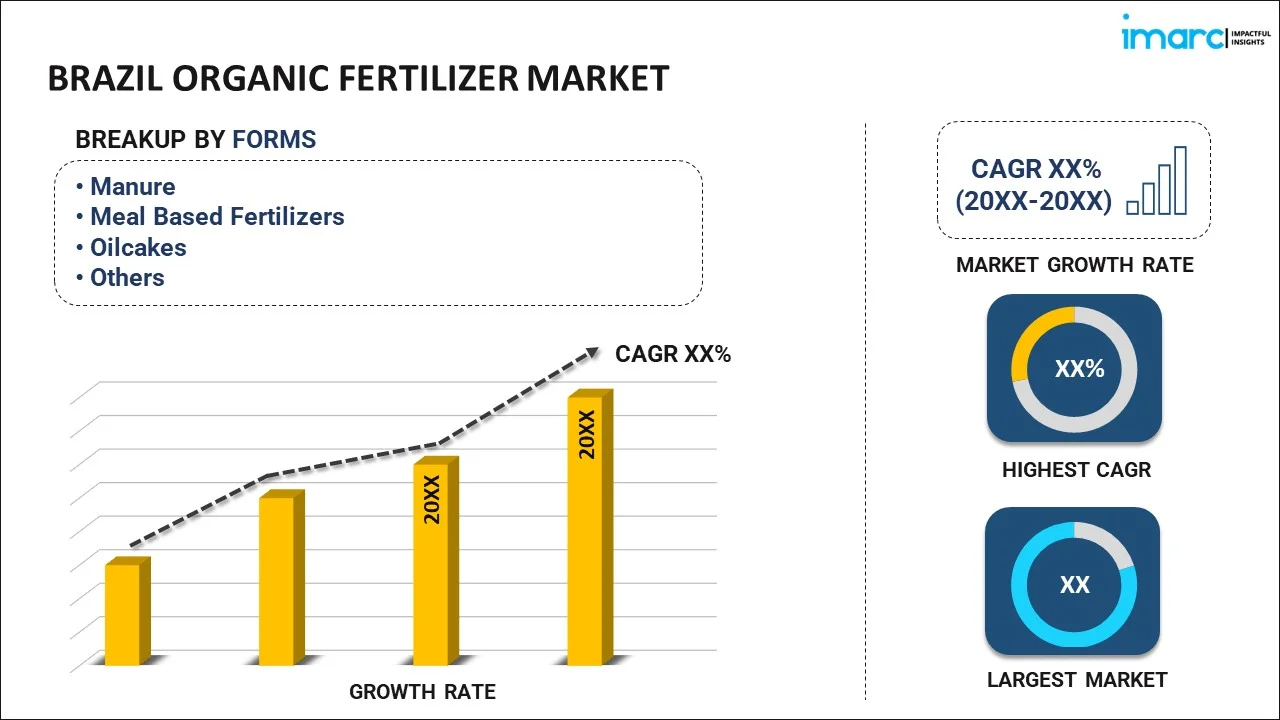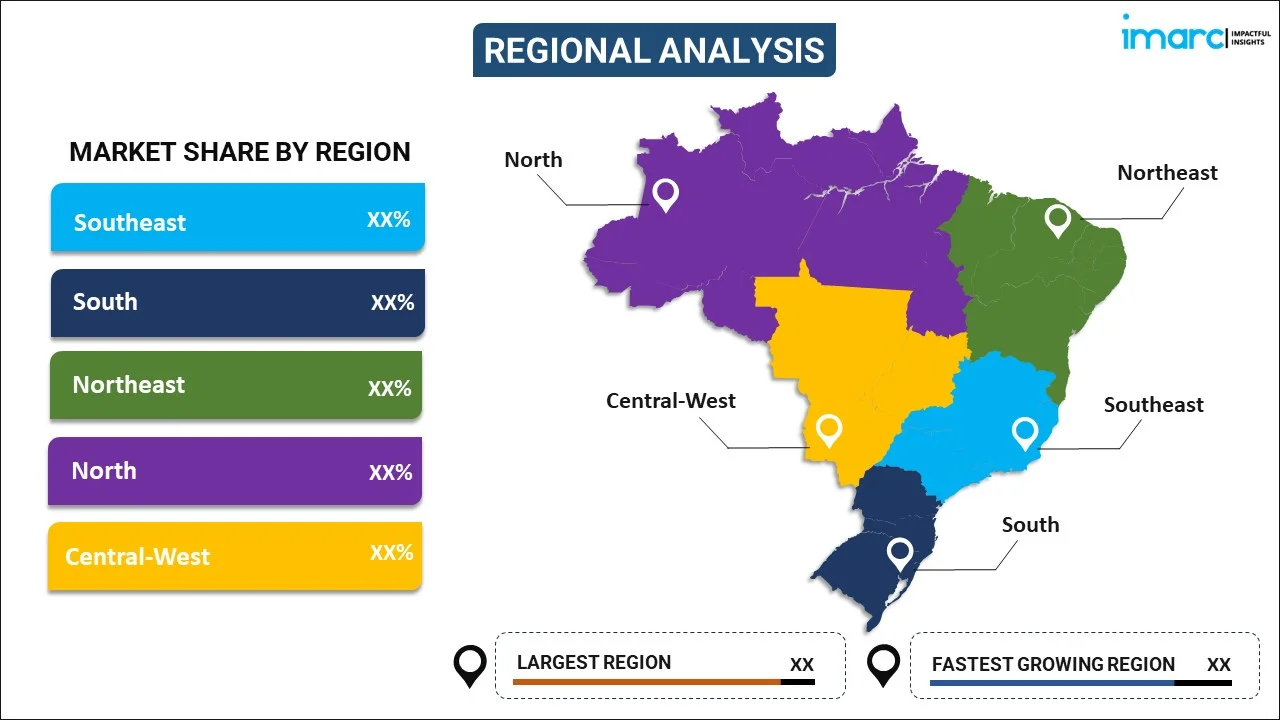
Brazil Organic Fertilizer Market Report by Form (Manure, Meal Based Fertilizers, Oilcakes, and Others), Crop Type (Cash Crops, Horticultural Crops, Row Crops), and Region 2024-2032
Market Overview:
Brazil organic fertilizer market size is projected to exhibit a growth rate (CAGR) of 8.62% during 2024-2032. The rising awareness among farmers and consumers about the importance of sustainable agriculture, the implementation of government initiatives and policies aimed at promoting organic agriculture, and the adoption of advanced technology in organic fertilizer production represent some of the key factors driving the market.
|
Report Attribute
|
Key Statistics
|
|---|---|
|
Base Year
|
2023 |
|
Forecast Years
|
2024-2032 |
|
Historical Years
|
2018-2023
|
| Market Growth Rate (2024-2032) | 8.62% |
Organic fertilizer is a type of natural plant nutrient that is derived from organic matter, such as decomposed plants and animal waste. It differs from synthetic or chemical fertilizers in that it promotes sustainable and environmentally friendly agriculture practices. It provides essential nutrients to plants in a slow-release manner, enriching the soil with organic material and improving its overall health. These fertilizers typically contain a balanced mix of nitrogen, phosphorus, and potassium, along with other micronutrients. They are free from synthetic chemicals, genetically modified organisms (GMOs), and harmful additives. Organic fertilizers offer numerous advantages, including enhanced soil fertility, improved plant growth, increased resistance to pests and diseases, and reduced environmental impact. They contribute to the development of healthier crops and, ultimately, support sustainable farming practices that prioritize long-term soil health and productivity.
Brazil Organic Fertilizer Market Trends:
The Brazil organic fertilizer market is experiencing a significant surge in growth, primarily driven by the heightened awareness among farmers and consumers about the importance of sustainable agriculture. As consumers become more health-conscious and environmentally aware, they are seeking products that are produced using eco-friendly methods, leading to a growing preference for organically cultivated crops. This consumer shift is incentivizing farmers to adopt organic farming practices and, consequently, boosting the demand for organic fertilizers in Brazil. In addition, government initiatives and policies aimed at promoting organic agriculture are playing a pivotal role in shaping the market landscape. The Brazilian government has been actively supporting organic farming through financial incentives, subsidies, and regulatory measures that encourage the use of organic fertilizers. This favorable policy environment is making organic farming more economically viable for growers and ensuring that organic fertilizers conform to high-quality standards. Additionally, the adoption of advanced technology in organic fertilizer production is a noteworthy trend. Manufacturers are investing in research and development to innovate and create more effective organic fertilizer formulations. This includes the development of specialized organic blends tailored to the specific nutrient needs of various crops. Such innovations are improving the efficiency of organic fertilizers, making them more competitive with synthetic alternatives. Furthermore, the export potential of Brazilian organic fertilizers is gaining prominence. Brazil's vast agricultural resources and the reputation for producing high-quality organic products are attracting international markets. This presents a significant growth opportunity for domestic organic fertilizer producers, who can expand their market reach beyond national borders and tap into the global demand for organic and sustainable agriculture.
Brazil Organic Fertilizer Market Segmentation:
IMARC Group provides an analysis of the key trends in each segment of the market, along with forecasts at the country level for 2024-2032. Our report has categorized the market based on form and crop type.
Form Insights:

- Manure
- Meal Based Fertilizers
- Oilcakes
- Others
The report has provided a detailed breakup and analysis of the market based on the form. This includes manure, meal based fertilizers, oilcakes, and others.
Crop Type Insights:
- Cash Crops
- Horticultural Crops
- Row Crops
A detailed breakup and analysis of the market based on the crop type have also been provided in the report. This includes cash crops, horticultural crops, and row crops.
Regional Insights:

- Southeast
- South
- Northeast
- North
- Central-West
The report has also provided a comprehensive analysis of all the major regional markets, which include Southeast, South, Northeast, North, and Central-West.
Competitive Landscape:
The market research report has also provided a comprehensive analysis of the competitive landscape in the market. Competitive analysis such as market structure, key player positioning, top winning strategies, competitive dashboard, and company evaluation quadrant has been covered in the report. Also, detailed profiles of all major companies have been provided.
Brazil Organic Fertilizer Market Report Coverage:
| Report Features | Details |
|---|---|
| Base Year of the Analysis | 2023 |
| Historical Period | 2018-2023 |
| Forecast Period | 2024-2032 |
| Units | US$ Million |
| Scope of the Report | Exploration of Historical Trends and Market Outlook, Industry Catalysts and Challenges, Segment-Wise Historical and Future Market Assessment:
|
| Forms Covered | Manure, Meal Based Fertilizers, Oilcakes, Others |
| Crop Types Covered | Cash Crops, Horticultural Crops, Row Crops |
| Regions Covered | Southeast, South, Northeast, North, Central-West |
| Customization Scope | 10% Free Customization |
| Report Price and Purchase Option | Single User License: US$ 3699 Five User License: US$ 4699 Corporate License: US$ 5699 |
| Post-Sale Analyst Support | 10-12 Weeks |
| Delivery Format | PDF and Excel through Email (We can also provide the editable version of the report in PPT/Word format on special request) |
Key Questions Answered in This Report:
- How has the Brazil organic fertilizer market performed so far and how will it perform in the coming years?
- What has been the impact of COVID-18 on the Brazil organic fertilizer market?
- What is the breakup of the Brazil organic fertilizer market on the basis of form?
- What is the breakup of the Brazil organic fertilizer market on the basis of crop type?
- What are the various stages in the value chain of the Brazil organic fertilizer market?
- What are the key driving factors and challenges in the Brazil organic fertilizer?
- What is the structure of the Brazil organic fertilizer market and who are the key players?
- What is the degree of competition in the Brazil organic fertilizer market?
Key Benefits for Stakeholders:
- IMARC’s industry report offers a comprehensive quantitative analysis of various market segments, historical and current market trends, market forecasts, and dynamics of the Brazil organic fertilizer market from 2018-2032.
- The research report provides the latest information on the market drivers, challenges, and opportunities in the Brazil organic fertilizer market.
- Porter's five forces analysis assist stakeholders in assessing the impact of new entrants, competitive rivalry, supplier power, buyer power, and the threat of substitution. It helps stakeholders to analyze the level of competition within the Brazil organic fertilizer industry and its attractiveness.
- Competitive landscape allows stakeholders to understand their competitive environment and provides an insight into the current positions of key players in the market.
Need more help?
- Speak to our experienced analysts for insights on the current market scenarios.
- Include additional segments and countries to customize the report as per your requirement.
- Gain an unparalleled competitive advantage in your domain by understanding how to utilize the report and positively impacting your operations and revenue.
- For further assistance, please connect with our analysts.
 Inquire Before Buying
Inquire Before Buying
 Speak to an Analyst
Speak to an Analyst
 Request Brochure
Request Brochure
 Request Customization
Request Customization




.webp)




.webp)












